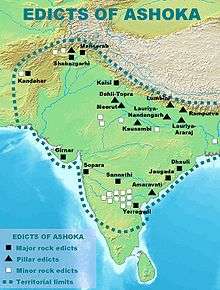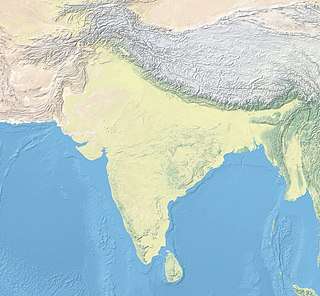Mansehra Rock Edicts
|
Detail of the upper rock inscription. | |
 Shown within Pakistan | |
| Location | Mansehra, Mansehra District, Khyber Pakhtunkhwa |
|---|---|
| Coordinates | 34°20′0″N 73°10′0″E / 34.33333°N 73.16667°ECoordinates: 34°20′0″N 73°10′0″E / 34.33333°N 73.16667°E |
| Site notes | |
| Website | UNESCO World Heritage Sites tentative list |

Mansehra Rock Edicts are fourteen edicts of the Mauryan emperor Ashoka, inscribed on rocks in Mansehra in Khyber Pakhtunkhwa, Pakistan. The edicts are cut into three boulders and date back to 3rd century BC and they are written in the ancient Indic script of Gandhara culture, Kharosthi. The edicts mention aspects of Ashoka’s dharma.[1][2] The site was submitted for inclusion in the World Heritage Sites and is currently in the tentative list.
Location
The edicts are inscribed on an outcrop of a small rocky mountain outside the city of Mansehra in Khyber Pakhtunkhwa province of Pakistan. The site is located near to the Karakoram Highway on the ancient Silk Route. The archeological city of Taxila is located in south and Abbottabad lies very near to the east of the site.[1]
History
Ashoka was dismayed by the destruction caused by his military during the conquest of Kalingas and in remorse later converted to Buddhism. Following his conversion, Ashoka visited sacred Buddhist locations throughout the Mauryan Empire and erected multiple pillars bearing his inscriptions of a new morality law. Mansehra Rock Edicts are one of the 33 inscriptions of Edicts of Ashoka describing expansion of Buddhism and his Law of Piety or dharma.[2]
The fourteen edicts contain text in the Kharosthi script which is an ancient script used in the Gandhara. The Kharoṣṭhi script was first deciphered by James Prinsep after which the Edicts of Ashoka in Kharosthi script were translated.[3]
Conservation
Due to environmental degradation, the rocks are eroding and the script is fading rendering it unreadable.[2] To protect the site, Department of Archeology and Museum, Pakistan provided canopies to cover the rocks and shelter them from weather conditions.[4]
World Heritage Site
In 2004, the site was submitted for inclusion in the UNESCO World Heritage Sites by Department of Archaeology and Museums, Pakistan. It was submitted in the Cultural criteria ii, iii, and vi.[1]
See also
References
- 1 2 3 "Mansehra Rock Edicts". World Heritage Centre. UNESCO. Retrieved 25 August 2012.
- 1 2 3 "Ashoka Rocks". Lonely Planet. Retrieved 28 August 2012.
- ↑ Cunningham, A (1877). Corpus Inscriptionum Indicarum. Volume 1. Inscriptions of Aśoka. Calcutta: Government of India.
- ↑ "Call to protect eroding rock edicts of Ashoka". Dawn News. Retrieved 28 August 2012.
External links
| Wikimedia Commons has media related to Mansehra Rock Edicts. |
- Gandhari - complete script of the fourteen edicts

